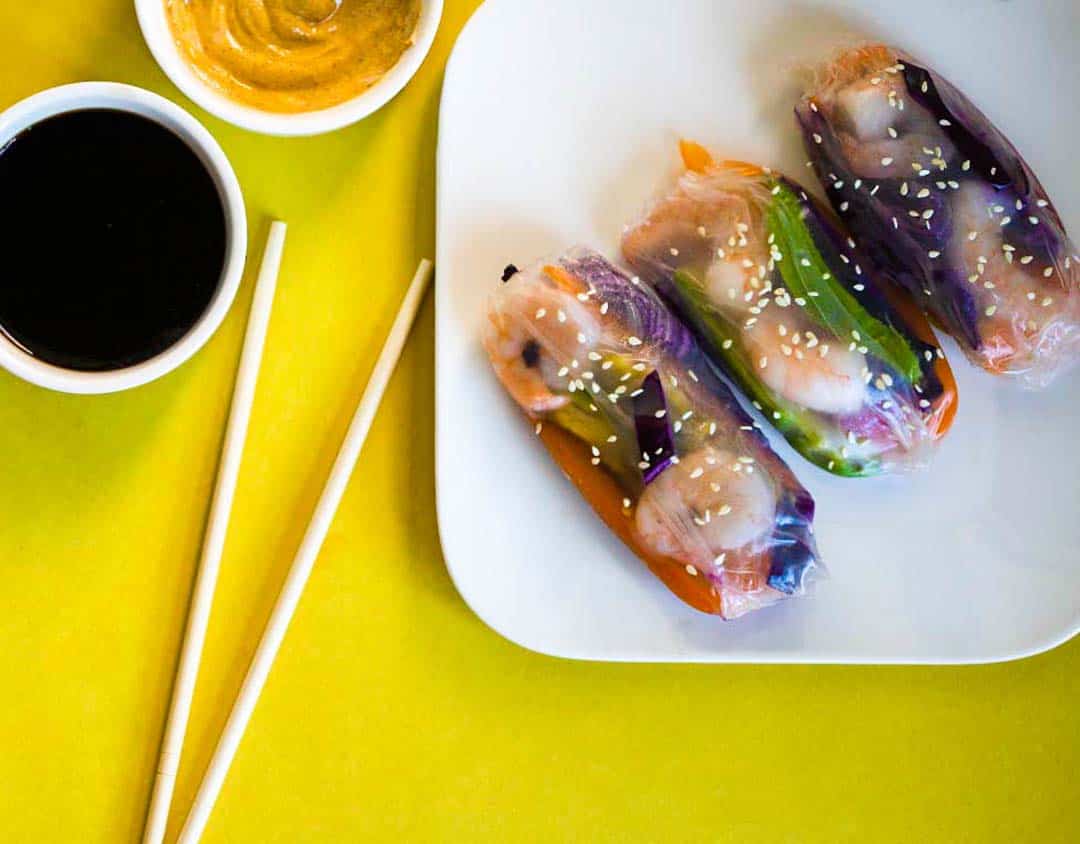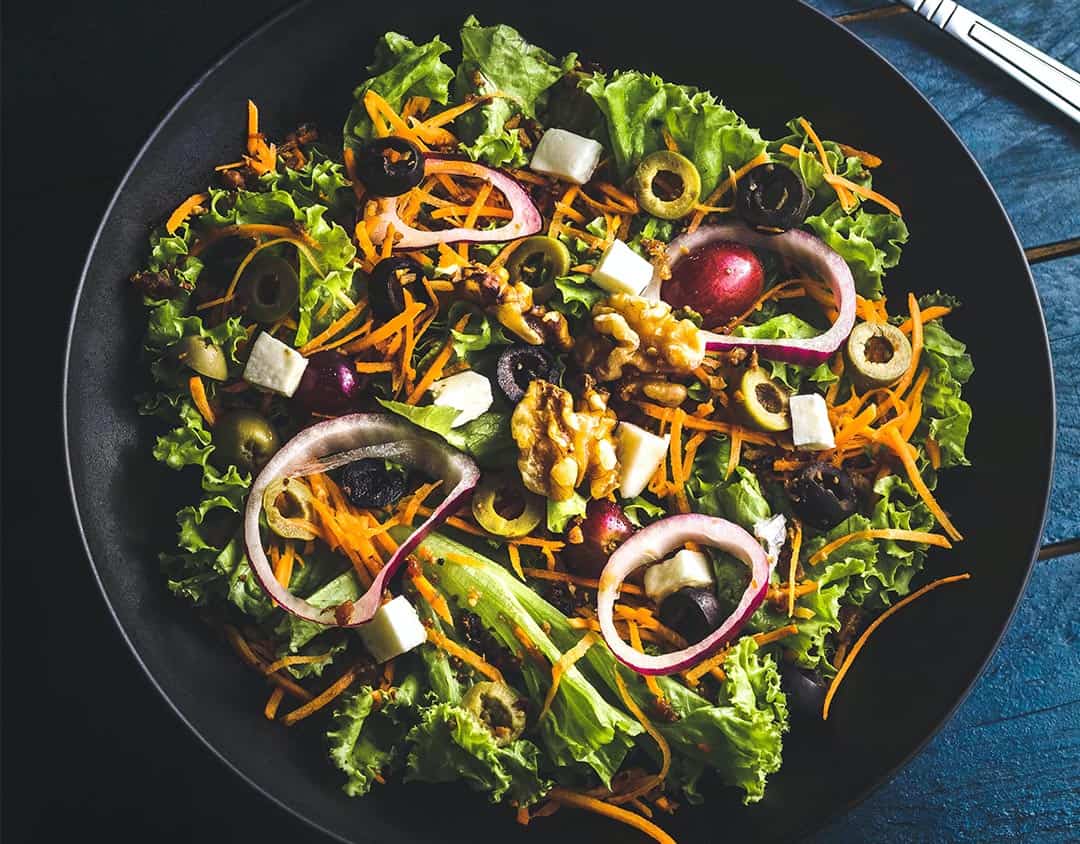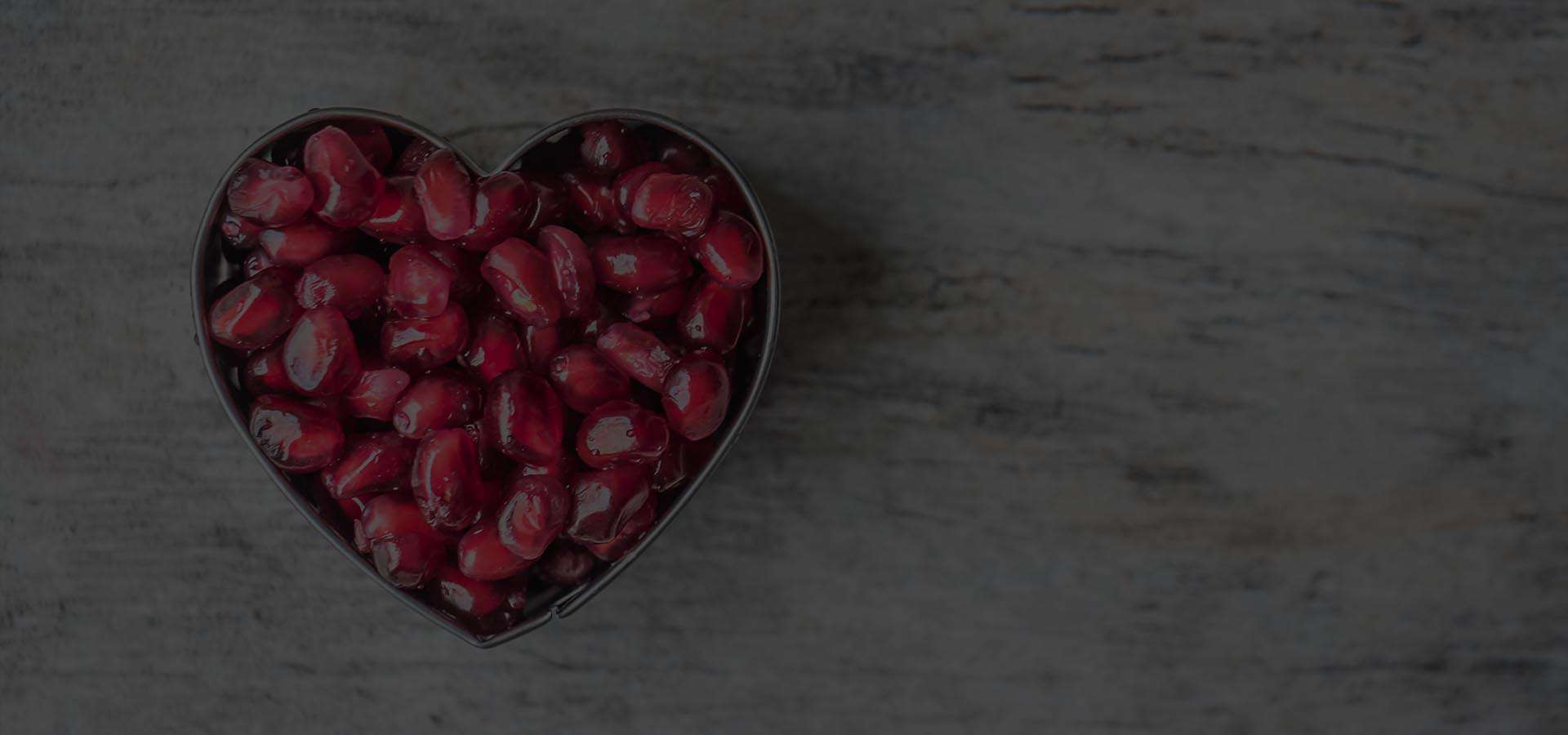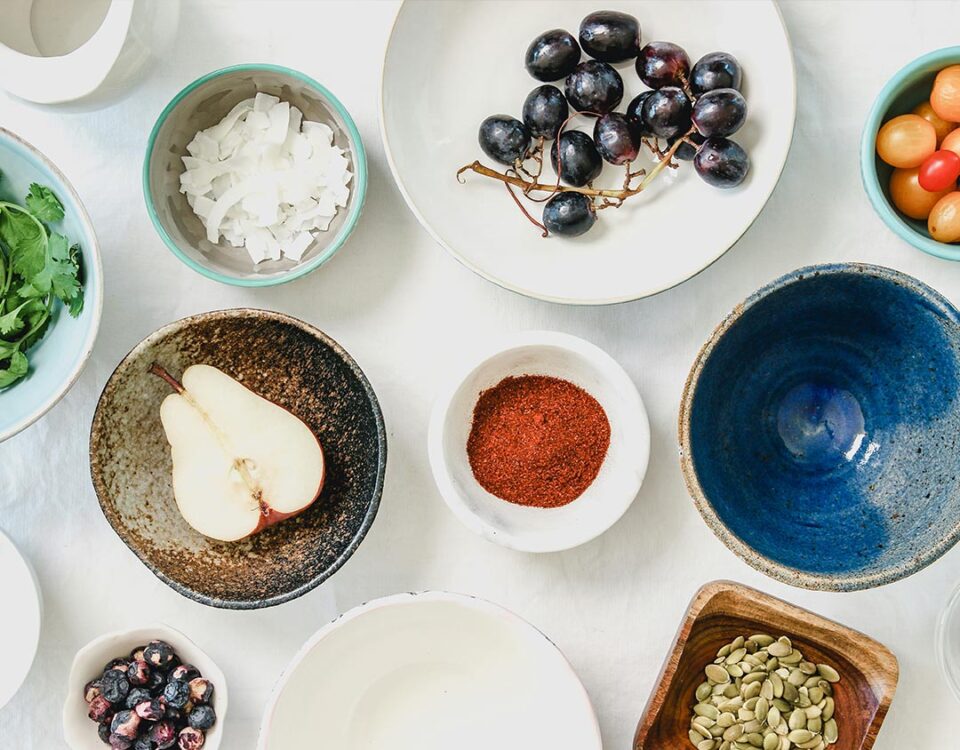
Easy Meal Planning
August 9, 2020
Vietnamese Salad Rolls with Peanut Dipping Sauce
October 29, 2020Although based on different principles, both mindful eating and intuitive eating promote self-compassion, self-trust, and an improved relationship with food.
W e’ve been experiencing a shift lately in the dieting world – people are starting to recognize the harms of dieting and starting to call out diet culture for its negative impacts on our health and well-being. Unfortunately, diet culture is sneaky and it has rebranded itself to “wellness culture”. Things that were once simply called a diet are marketing themselves now as a “lifestyle change”, with just as many rules and restriction and negative impacts on our relationship with food and body as before.
If you’ve experienced the negative impacts of dieting, such as increased preoccupation and anxiety with food, increased preoccupation with your body shape/size, overeating/binge eating, low energy, increased cravings, guilt/shame… you’ve likely felt completely defeated at times and put the blame of failure onto yourself, even though it was never your fault. Side note, there is no judgement or shame for wanting to diet, we live in a messed-up culture that elevates certain body types over others and oppresses larger bodied individuals, but that’s a whole other discussion.
For many of us, we get trapped in the dieting cycle and feel that there is no way out, no way to possibly trust or connect with our bodies in a way that brings peace with food. We’ve been told that in order to “eat healthy” we must have discipline, rules and restriction. Mindful eating and intuitive eating allow us to reconnect with our bodies and help us work towards breaking this dieting cycle.

MINDFUL EATING
“Mindfulness is the capacity to bring full attention and awareness to one’s experience, in the moment, without judgment. Mindful Eating brings mindfulness to food choice and the experience of eating. Mindful eating helps us become aware of our thoughts, feelings, and physical sensations related to eating, reconnecting us with our innate inner wisdom about hunger and satiety.” - The Centre for Mindful Eating
In other words, mindful eating is paying attention to the sensations in our body and the thoughts/emotions that arise during a meal, snack or eating experience. Rather than coming into a meal with pre-conceived ideas on how we should feel about this food (e.g. guilty for enjoying something we love or proud for sticking to a diet rule), we come into the eating experience curious and ready to listen/connect with our bodies. This allows us to tune into the tastes, textures, nourishing aspects of the food, as well as identify what we like about it, how it makes us feel, and how much we would like to eat to feel comfortably satisfied. Every eating experience is unique and there is no right or wrong sensations or feelings.
Eating mindfully provides many benefits, such as:
- Increased awareness of how food makes you feel during and after a meal
- Better understanding of which foods you enjoy eating and which ones you dislike
- Increased enjoyment, satisfaction and pleasure from food
- Better understanding of your motivations for eating (e.g. physical hunger, cravings, emotions)
- Increased appreciation and gratefulness for your food
- Increased ability to cope with non-physical reasons for eating
- Decreased feelings of guilt and shame around food by identifying the non-nutrition benefits of food
How do we incorporate mindfulness while eating?
- It is likely not realistic to eat mindfully all the time or throughout an entire eating experience, so when starting out, try to simply take a moment to check in with your body for the first bite, mid-way bite, and last bite of an eating experience
- At each check-in, consider the following questions:
- How am I currently feeling? Calm, stressed, anxious, relaxed, tired, in a rush?
- What is motivating me to eat right now, am I physically hungry, am I craving something specific, am I looking for comfort, am I bored, am I eating now because I don’t have time to eat later?
- Where has this food come from? Take a moment to appreciate the privilege of having access to food
- How does this food taste, what textures and flavours come through?
- What do I enjoy about this food? What do I dislike about this food? Is this food satisfying to me?
- How hungry or full do I feel? Am I satisfied, have I had enough or should I go back for more?
- How does this food/meal make me feel physically and emotionally?
- Try to eat slowly and chew thoroughly – feel the food move around your mouth
- If possible, try to limit distractions during the eating experience (e.g. doing work, being on your phone, watching TV) as this may prevent us from checking in or noticing the signals our body sends
Check out this raisin eating exercise as an example of mindful eating: https://ggia.berkeley.edu/practice/raisin_meditation


INTUITIVE EATING
We are born intuitive eaters. When we’re young, we trust our body’s cues, which let us know when we are hungry and need food, and when to pull away or push food away when we are full/satisfied. Unfortunately, as we age, things like diet messaging, rules of having to finish our food before leaving the table, or "nutrition education" that categorizes foods as “good” or “bad”, result in us losing touch with our intuitive eater.
Intuitive Eating and its 10 principles were developed by two dietitians Evelyn Tribole and Elyse Resch in 1995. The most recent fourth edition was released in June 2020. Intuitive eating encompasses the principles of mindful eating, but extends further to incorporate your instinct, emotion and rational thoughts about food to help you to move past fear and judgement and find true satisfaction and peace when eating. It is an evidence-based, mind-body health approach that helps us to break free from the diet mentality.
Here’s an overview of the 10 concepts of intuitive eating:
1. Reject the diet mentality
- Recognizing the damage that dieting causes not only to our physical health but our mental and emotional health is the first step towards rebuilding a healthy relationship with food
- Identifying all the different forms of diet culture and diet mentality in our daily life helps to tease out where these feelings and reminders of failure, lack of willpower, rules, and restrictions come from
- Getting rid of any dieting tools that we use to “stay on track” and monitor our weight, such as diet books, magazines, weight scales, calorie counting apps, and even social media sources that make us feel like we are not enough or worthy unless we change our bodies
- Accepting and acknowledging that you are the expert of your body, and that you don’t need rules and restrictions to determine what, when and how much to eat
- Resist falling prey to any diet/way of eating that promises weight loss, as the results are often only short term
Action to try: When you see or hear diet messages, or think a diet mentality thought - identify and name it. For example, stop to identify rules you have in regards to food, such as “I shouldn’t eat after 7pm”, “I should only eat foods from the perimeter of the store”, “I shouldn’t eat anything with added sugar” (anything that is rigid and has no flexibility is a rule). Calling out these thoughts is the first step towards repairing our relationship with food.
2. Honour your hunger
- One reason dieting often doesn't work is because it leaves you feeling hungry and deprived, this can trigger the drive to overeat or feelings of being out of control with food later on
- Start by checking in with your body throughout the day to see if you notice any signs of hunger - early (e.g. thinking about food, getting excited to eat, empty stomach feeling) vs late (e.g. light headed, tired, irritable, weak, dizzy, nauseated, stomach growling). Knowing your signs of hunger can help to ensure that you address them earlier on rather than later each day
- Notice the nuances of this sensation in YOUR body
- When you notice these hunger cues, make time to eat
- Nourishing your body with adequate energy (calories) and carbohydrates when it asks for food promotes overall health and your relationship with food
- Note that if you do not eat regularly (e.g. restrict your eating, engage in intermittent fasting) or are experiencing illness your hunger cues may no longer be present or reliable, in this case it is important to build back a consistent and adequate eating routine first
Action to try: Check in with your body every 2-3 hours throughout the day to identify if your body needs energy/fuel. Keep snacks on hand so when you feel hunger coming on, you can honour it right away!
3. Make peace with food
- Depriving yourself from certain foods (either physically or psychologically) often results in rebound eating and guilt, which then makes us feel the need to deprive ourselves all over again and the cycle continues
- The way to break this cycle is to make peace with all foods and truly know that nothing is off limits
- All foods benefit our overall well-being in one way, shape or form - they either provide energy/fuel, protein, fats, carbs, fibre, vitamins/minerals, pleasure, comfort, enjoyment, satisfaction and more
- Giving yourself unconditional permission to eat all foods can seem scary at first and we will often overeat it when starting out since we have never had full permission to eat it in the past. However, with this new permission and mindful eating, we can slowly begin to pay attention to how that food makes us feel and what quantity of food makes us feel good and satisfied, sometimes we may even notice that we don’t actually even enjoy eating the foods we had kept off limits for years
- Make a cookie emotionally/morally equivalent to spinach - one is not more "right" than the other
Action to try: Think about a food that you usually don’t allow yourself to have (e.g. ice cream, cookies, chips, fries). Go purchase that food and keep it in your house from now on so its fully available and you have full permission to eat it. When you crave it/enjoy it, engage in mindful eating (see above). Anytime you honour that craving, you’re gradually restoring your body’s trust that you will listen to what it asks for and that there are no restrictions.
4. Challenge the food police
- The food police is that voice in your head that tells you what foods are “good” and what foods are “bad”
- The food police in your mind monitors the rules of diet culture
- It’s the voice that congratulates you when you restrict yourself enough that day or makes you feel guilty for “indulging” at a holiday party
- There is no moral value associated to food
- Identify and challenge these voices or thoughts with more rationale and positive thoughts
Action to try: when you notice a food police thought (e.g. "this cake is high in calories and will make me gain weight"), replace it with a positive alternative statements (e.g. "If I eat this cake, I will get to enjoy my friends baking, feel satisfied, and give my body energy."
5. Discover the satisfaction factor
- Feeling truly satisfied from your food is one of the most important aspects of intuitive eating
- Give yourself permission to seek pleasure in your eating experiences
- What foods do you truly enjoy eating, which meals make you feel completely satisfied afterwards, making it very easy to move onto the next part of your day without further thinking about food
- Concentrate on not only the taste and texture of the food itself, but the whole dining experience (sounds, environment), what do you find satisfying about it, and what would improve the experience?
- Observe how you feel after eating. Does your stomach hurt? Do you feel lethargic? Do you feel good? Do you feel satisfied?
- Many other cultures emphasize the importance of finding pleasure from their food (e.g. Japanese culture)
Action to try: consider what foods seems truly satisfying to you right now in this moment. Is it crunchy, warm, sweet, cold, savoury? What about that food makes it satisfying?

6. Feel your fullness
- Take your time while eating to start to recognize what it feels like to be comfortably full and not overly full
- Use mindful eating strategies to enjoy the look, smells, and tastes of the food you are eating to really enjoy the experience and identify when you’re getting close to being comfortably full
- Reject the “needing to finish what's on your plate” mentality
- Take a moment to pause in the middle of a meal and check in with how you feel, are you still eating because you’re still hungry, or is it because you’re bored, or because there’s still food in front of you? Or maybe you don’t allow yourself to eat this food often and don’t want the experience to be over
Action to try: check in with your hunger/fullness level at the first bite, the mid-meal bite, and the last bite of your meal. Start to identify what a comfortable fullness level feels like for you.
7. Cope with your emotions with kindness
- Eating enjoyable food is often an easily accessible coping strategy that many of us develop to respond to unwanted/negative emotions
- There is nothing wrong with eating for emotional reasons and using food to comfort, nurture, distract or numb certain emotions, but you may find that eating often doesn't address the root cause/trigger, and as soon as we're finished eating, we're back to feeling how we did before.
- Instead, we want to take a moment to identify our motivations for eating, take a moment to ask yourself what am I feeling? Identifying the emotion that is leading to emotional eating is the first step towards addresses the root cause
- Next, ask yourself what need is not being met and what can I do to meet that need without food. Do I need more sleep? Do I need to talk to someone? Do I need to engage in an activity or hobby to feel mentally stimulated? Do I need to take some time to myself to relax?
- Lastly, consider what other coping strategies you have in your tool box to address these emotions. For example, for stress - going for a walk outdoors, doing a puzzle, taking a hot shower, reading a book, deep breathing, stretching, and more.
Action to try: make a list of all the emotions that often drive you to eat (e.g. loneliness, boredom, stress, anxiety, sadness) and list as many coping strategies beside each one that you can think of to address those unwanted emotions
8. Respect your body
- We never expect to change our shoe size or our height, yet we continuously put pressure on ourselves to shrink/change the shape of our bodies. Learning to accept our genetics and the natural shape of your body helps to promote a positive body image.
- Rather than jumping straight into loving all parts of your body, start by learning to respect and appreciate your body for what it does for you
- Consider how you can show your body respect each and every day by meeting its basic needs for health (e.g. eating enough food, moving it in enjoyable ways, getting enough sleep, wearing clothes that fit and are comfortable)
- Over time, this body respect and acceptance can turn into appreciation and in some cases, a loving relationship with your body
- This chapter discusses how to stop body-bashing, how to respect body diversity, and how accept your natural body weight
- Embracing the Health at Every Size Principles
Action to try: make a list of ways that you can show your body respect, meet its basic needs, and keep it comfortable on a regular basis. You can also consider making a list of things that you appreciate about your body, what does it do for you each day that you appreciate?
9. Movement - feel the difference
- Moving your body in enjoyable and sustainable ways is key to good health
- Movement can help us to feel strong, energized, and comfortable in our bodies
- Decouple movement from weight loss and consider all the empowering and health promoting benefits we get from movement aside from burning calories (e.g. flexibility, improved mood, increased energy, improved stamina, strength)
- Movement should not be used to make up for foods previously eaten or to allow yourself to eat more later, try to keep it for enjoyment and moving your body to feel good, empowered, and strong
Action to try: consider the intention behind your movement? Is it to change your body or to feel good in your body?
10. Honour your health - gentle nutrition
- Choosing foods that you enjoy and satisfy you is important, as is choosing foods that are jam-packed with nutrients that promote your physical health
- Remember that you don’t have to eat nutritious foods all the time to be healthy, and all foods fit in a healthy eating pattern
- Using a combination of nutrition knowledge (e.g. how to get enough protein in the day, how to add fibre to meals, the benefits of balancing your meals) with your internal hunger, satisfaction, and fullness cues will lead to the optimal relationship with food long term
Action to try: when able, try to balance your meals by incorporating an enjoyable protein-rich food, starches, fats, and vegetables/fruit to optimize your energy levels throughout the day and overall health


There are hundreds of research studies that have shown the benefits of intuitive eating, such as:
- Improved self-esteem and body image
- Increased body appreciation
- Decreased rates of emotional eating
- Decreased rates of disordered eating
- Improved emotional coping skills
- Higher HDL cholesterol levels and lower triglyceride levels
- Increased satisfaction in life
- And more!
Neither mindful eating nor intuitive eating are diets or rules to follow, and neither should be promoted for the purposes of losing weight or to change body size/shape. If anyone is marketing mindful or intuitive eating for the purposes of weight loss – run in the other direction. I should note that connecting with your body may not be possible or safe for everyone. If you’ve experienced trauma or are struggling with an eating disorder, these tools may not be appropriate for you right now and that’s okay. If you’re interested in learning more about these tools and if they could be helpful in your life, connect with a registered dietitian who is well-versed in both.
Mindful eating and intuitive eating are two strategies that you can use to reconnect to your here-and-now body and learn to trust, connect with and respect it again, ultimately breaking the dieting cycle and improving your relationship with food.
Written by Liz Powell, RD and Joy Tang
Resources: https://www.intuitiveeating.org/ https://www.thecenterformindfuleating.org/




